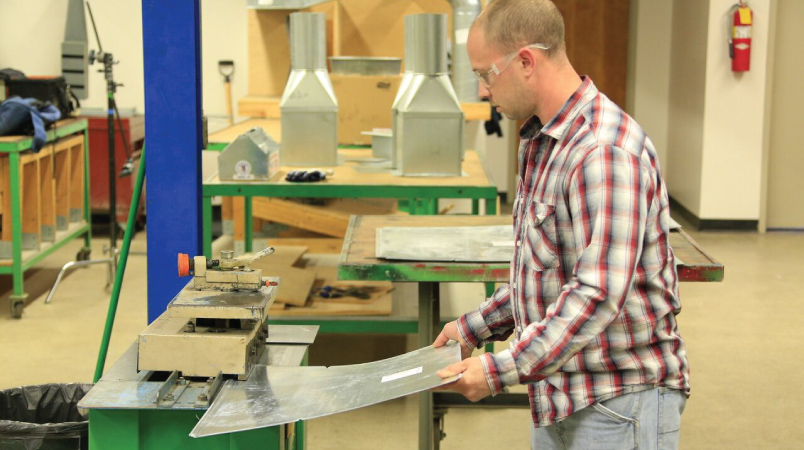The pharmaceutical industry is one of America’s biggest providers of secure, middle-class jobs. Here are five points on the jobs the industry creates and the investments it makes in science and math education in the U.S.
The pharmaceutical industry supports 50,000 trucking jobs and other supply line jobs that contribute $30B annually to the U.S. economy
Jobs in trucking, construction and manufacturing are the foundations of the American middle class, and the pharmaceutical industry employs tens of thousands of workers who build the facilities where drugs are made, help manufacture treatments and packaging, and drive across the highways of America to bring these life-saving medicines to local drug stores. In addition to 50,000 trucking jobs, the industry also supports 93,000 building services jobs, 6,000 manufacturing jobs, and 12,000 jobs for professionals in the electricity field. Steven Mongiardo, Executive Director of Global Facilities Management at Merck, compared his job managing a pharmaceutical facility site in southern Pennsylvania to being the mayor of a city. “The site is a small city – we have roughly 10,000 workers working in 6 million square feet of facility space,” he said. These workers have high-quality jobs that are often unionized, adding more than $30 billion total in value to the U.S. economy while at the same time ensuring that life-saving medicines reach those who need them the most.
The pharmaceutical industry is creating vocational, skills-based jobs that pay good wages
Vocational, trade-based science, technology, engineering and math (STEM) jobs are a critical building block of the American economy. These jobs—which usually require an associate’s degree or some accredited post high school training—are some of the very jobs President Obama had in mind when he announced America’s College Promise in his 2015 State of the Union address, a plan to provide free community college education to all students. Pharmaceutical companies are one of the top employers of vocationally-based STEM jobs. One such job in this category is a lab technician, a professional who helps drug researchers collect data, maintain equipment and calculate results. Lab technicians are required to have an associate’s degree and earn an average of $40,000 a year. The number of lab tech jobs is expected to grow by almost 30% between 2012 and 2022, creating approximately 47,900 additional jobs.
The pharmaceutical industry is a tech and innovation leader, on par with Silicon Valley
America has long been the global innovation leader—the telephone, television, and the internet are just a few of thousands of U.S. inventions that have changed the world. When you think “innovation” in the 21st century, you might think of Silicon Valley icons such as Jack Dorsey or Elon Musk. But the biopharmaceutical sector actually supports many of the jobs that make America the world’s top innovation hub. Merck’s Mongiardo said that though the physical products are small in the pharmaceutical industry—vials, syringes, capsules/tablets etc.—the scale of what’s required to produce these products is “magnitudes larger.” Numerous software engineers work in the biopharmaceutical sector, writing programs that allow researchers to track clinical drug trials and their outcomes. The industry also employs many of the top Ph.Ds. in chemistry and biology, biostatisticians, and more. The industry is a magnet for the best and brightest STEM professionals globally, which ensures that America remains the most innovation-driven economy in the world.
The pharmaceutical industry recognizes union jobs
Throughout American history, organized labor has been key to ensuring that workers have safe conditions, good benefits, competitive wages, and more. The pharmaceutical industry recognizes that importance. The Pharmaceutical Industry Labor Management Association (PILMA) is a unique coalition of pharmaceutical industry companies and the unions that represent their workers. PILMA works to provide training to workers, organize conferences, and give tours of training facilities to industry professionals. PILMA, in that vein, represents uncommon cooperation between unionized workers and the industries that employ them. “We need highly-skilled tradesmen, more so than most industries,” Mongiardo says, adding that many of the building trades unions have the best vocational training programs that he has seen. And Allan Rhodes, a Testing and Balancing Instructor at the Sheet Metal Workers Local 19 union, emphasized that since manufacturing stainless steel (frequently used at pharmaceutical plants because of their need for extremely clean environments) is more complicated than regular steel, training is of utmost importance. “It’s an intense training program that even apprentices go through,” he said. “I think it’s at least two nights a week, just getting your feet wet.”

Pharmaceutical companies are helping educate tomorrow’s workforce
The U.S. is struggling to keep up with countries like China and India in science and math education. According to a recent report by the President’s Council of Advisors on Science and Technology, the U.S. will need to produce one million additional STEM graduates over the next decade to maintain its position as the world’s leader in science and technology innovation. To meet this critical national need, pharmaceutical companies have funded almost 100 initiatives to improve STEM education in the United States. Companies including GlaxoSmithKline, AstraZeneca, and Bayer USA sponsor events like the U.S. Science and Engineering Festival and support summer science camps. These initiatives aim to develop early interest in STEM careers among children—especially girls and minorities—and end the shortage of STEM professionals in the U.S.







It would really be nice if it were actually legal/easy to post comments on these ‘sponsored messages’